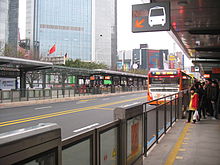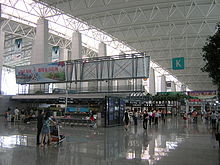About the City-Guangzhou
Geography
Located in the south-central portion of Guangdong, Guangzhou spans from 112° 57' to 114° 03' E longitude and 22° 26' to 23° 56' N latitude. The city is part of the Pearl River Delta and the city centre is situated next to the Baiyun Mountain, which is locally referred to as ‘the lung of the city’ (市肺). The total area under the city's administration is 7,434.4 square kilometres (2,870.4 sq mi), with the 10 districts occupying 3,843.43 square kilometres (1,483.96 sq mi), or 51.7% of the total, while the two county-level cities occupy the rest.
The elevation of the prefecture generally increases from southwest to northeast, with mountains forming the backbone of the city, and the ocean comprising the front.
Climate
Located just south of the Tropic of Cancer, Guangzhou has a humid subtropical climate (K?ppen Cfa) influenced by the East Asian monsoon. Summers are wet with high temperatures, high humidity and a high heat index. Winters are mild and comparatively dry. Guangzhou has a lengthy monsoon season, spanning from April through September. Monthly averages range from 13.6 °C (56.5 °F) in January to 28.6 °C (83.5 °F) in July, while the annual mean is 22.6 °C (72.7 °F),[5] the relative humidity is approximately 68%, whereas annual rainfall in the metropolitan area is over 1,700 mm (67 in). Extreme temperatures have ranged from 0 °C (32 °F) to 39.1 °C (102 °F). The last recorded snowfall in the city was in January 1893.
Public Transport
Guangzhou Metro
When the first line of the Guangzhou Metro opening in 1997, Guangzhou was the fourth city in Mainland China to have an underground railway system, behind Beijing, Tianjin and Shanghai. Currently the metro network is made up of eight lines, covering a total length of 236 km (147 mi). A long term plan is to make the city's metro system expand to over 500 km (310 mi) by 2020 with 15 lines in operation.
Shanghai. Currently the metro network is made up of eight lines, covering a total length of 236 km (147 mi). A long term plan is to make the city's metro system expand to over 500 km (310 mi) by 2020 with 15 lines in operation.
Buses, taxis and motorcyles
The Guangzhou Bus Rapid Transit (or GBRT) system which was introduced in 2010, is the world's second largest Bus Rapid Transit system with 1,000,000 passenger trips daily and 26,900 pphpd during the peak hour (second only to the TransMilenio BRT system in Bogota). The system averages 1 bus every 10 seconds or 350 per hour in a single direction contains the world's longest BRT stations - around 260m including bridges.
In 2009, is was reported that all 9,424 buses and 17,695 taxis in Guangzhou would be operating on LPG-fueled by 2010 to promote clean energy for transport and improve the environment ahead of the 2010 Asian Games which were held in the coty. At present, Guangzhou is the city that uses the most LPG-fueled vehicles in the world, and at the end of 2006, 6,500 buses and 16,000 taxis were using LPG, taking up 85% of all buses and taxis.
Effective January 1, 2007, the municipal government has banned motorcycles in urban areas. Motorcycles found violating the ban will be confiscated. The Guangzhou traffic bureau claimed to have reported reduced traffic problems and accidents in the downtown area since the ban.
Air transport Guangzhou's main airport is the Baiyun International Airport in Huadu District opened on August 5, 2004. This airport is also the 2nd busiest airport in terms of traffic movements in China. It replaced the old Baiyun International Airport, which was very close to the city centre and failed to meet the fast-growing air traffic demand.
Guangzhou's main airport is the Baiyun International Airport in Huadu District opened on August 5, 2004. This airport is also the 2nd busiest airport in terms of traffic movements in China. It replaced the old Baiyun International Airport, which was very close to the city centre and failed to meet the fast-growing air traffic demand.
Guangzhou Baiyun International Airport now has two runways, with three more planned to be built.
Railway transport
Guangzhou is the terminus of the Jingguang railway (Beijing-Guangzhou), the Guangshen railway (Guangzhou-Shenzhen), the Guangmao railway (Guangzhou-Maoming) and the Guangmeishan railway (Guangzhou-Meizhou-Shantou). In late 2009, the Wuhan–Guangzhou High-Speed Railway started its service, which enables multiple unit trains to cover 980 km (608.94 mi) at an average speed of 320 km/h. In January 2011, the Guangzhou–Zhuhai Intercity Railway started its service at an average speed of 200 km/h (124 mph)
Culture
According to the official People's Daily newspaper, Cantonese is the first language for half of the 14 million residents of the provincial capital Guangzhou, while the other half speak mainly Mandarin. Other languages such as Hakka are spoken in significant numbers as well. The migrant population from other provinces of China in Guangzhou is 40 percent of the city's total population in 2008. Most of them are rural migrants and they speak only Mandarin.They have taken on many jobs that the local citizens are unwilling to do
Foods
Guangdong has long been a trading port and many imported foods and ingredients are used in Cantonese cuisine. Besides pork, beef and chicken, Cantonese cuisine incorporates almost all edible meats, including offal, chicken feet, duck's tongue, snakes, and snails. However, lamb and goat are rarely eaten, unlike in the cuisines of northern or western China. Many cooking methods are used, with steaming and stir frying being the most favoured due to their convenience and rapidity. Other techniques include shallow frying, double steaming, braising, and deep frying.
For many traditional Cantonese cooks, the flavours of a finished dish should be well balanced and not greasy. Apart from that, spices should be used in modest amounts to avoid overwhelming the flavours of the primary ingredients, and these ingredients in turn should be at the peak of their freshness and quality. There is no widespread use of fresh herbs in Cantonese cooking, in contrast with their liberal use in other cuisines such as Sichuan, European, Thai or Vietnamese. Garlic chives and coriander leaves are notable exceptions, although the latter are usually used as mere garnish in most dishes.
